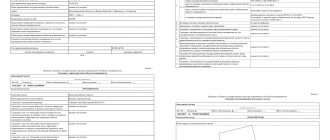Where to contact?
There is a certain sequence of actions:
- The first step (in the case when everything happens on a voluntary basis) is to draw up a special document - “Agreement on the division of non-residential premises.” This document describes in detail how the premises will be divided and the conditions of this process.
- Then you need to contact the BTI and call a technician, who, after inspecting the premises and taking measurements, will produce new technical plans and technical passports for each selected part.
- Order cadastral extracts from Rosreestr.
- Apply with a complete package of documents to the local branch of Rosreestr.
If there is no way to voluntarily divide the non-residential premises, or it is not possible to reach an agreement by mutual consent, then you will have to go to court in order to forcefully divide the real estate in the future. Then, on the basis of a court ruling, it will be possible to apply to the BTI.
Documentation
To complete the division procedure, the following documents will be required (provided for by Federal Law No. 218-FZ):
Articles on the topic (click to view)
- How is an agreement for the assignment of rights to an apartment under the DDU drawn up?
- What is more profitable: to continue living in a municipal apartment or to privatize it?
- The Supreme Court of the Russian Federation on the redevelopment and reconstruction of premises in an apartment building
- How does a mortgaged apartment become a property?
- Written consent of one of the spouses for the alienation, sale of the apartment and its sample
- What to do with a mortgaged apartment if a decision is made to divorce
- SAC RF: It is impossible to recognize a property as ownerless if the owner has not registered ownership of it
- An application to Rosreestr, which must contain a request to terminate the right of common shared ownership of this non-residential premises and to register individual ownership for each part (in accordance with technical passports). All owners sign the application.
- Agreement on division of premises.
- Title documents for this (original) object.
- Technical and cadastral documents for the original object.
- Extract from the Unified State Register of Real Estate.
- Technical documentation for new objects (parts of non-residential premises).
- Copies of passports (of all applicants).
- Receipts for payment of state duty (separate for each part).
- applications for termination of the right of common shared ownership of non-residential premises
- applications for termination of the right of common shared ownership of non-residential premises
Allotment of a share in kind in non-residential premises
Since a part, a share of the premises is not considered a separate independent object (Article 128, paragraph 1 of Article 131 of the Civil Code of the Russian Federation, Article 1 of the Law of July 21, 1997 N 122-FZ “On State ...”), then everyone’s desire is understandable of the co-owners, divide the object officially and record it in documents so as not to depend on each other in ownership rights.
For this purpose, a share is allocated in kind, and it should be noted that this is not always possible from a purely technical point of view.
Reference ! It is ideal if you can fence off or build a separate entrance to part of the non-residential premises. And when this is impossible, what should you do? In this case, the co-owners have the right to draw up an agreement (clause 1 of Article 252 of the Civil Code of the Russian Federation).
If it is not possible to disperse peacefully, then you should go to court with a demand to allocate your share in kind (clause 3 of Article 252 of the Civil Code of the Russian Federation). The court will take into account how realistic it is to separate one share without prejudice to the use of other parts.
Check out the video below about allocating shares in kind:
If technology does not allow or if one of the shares is so small that it is not possible to allocate it, the court may oblige the other co-owners (or one of them) to compensate this shareholder for the cost of his share, of course, with his consent.
The court will also take into account how painless it will be for others to allocate one part of the real estate in kind, since redevelopment and alteration of utilities may be required, which will entail significant material costs for other shareholders.
What are the financial expenses?
The following expenses will be incurred:
- Payment of the state fee for registration of property rights is 2 or 22 thousand rubles, depending on whether the applicant is an individual or a legal entity.
- Payment of the state fee for registration of property rights is 2 thousand rubles (from an individual) or 22 thousand rubles (from a legal entity).
- Payment of the state duty for the production of a technical passport is 1200 rubles (if required urgently, then 2.5 thousand rubles).
What is given at the end of the procedure?
At the end of the procedure, the owners (each for their allocated part) receive:
- Separate cadastral numbers (how the number of non-residential premises is assigned during cadastral registration is written here).
- Extracts from the Unified State Register of Real Estate, which reflect information about the new premises that were formed as a result of the division and about the owner (certificates of ownership are not currently issued).
The division is considered completed once the rights of each owner are registered. Simultaneously with the cadastral registration of new objects, registration actions must also be carried out.
It is worth remembering that after dividing the premises into parts, the rights of shared ownership are retained (Article 250 of the Civil Code of the Russian Federation). Based on this, each co-owner has the right of first refusal in the event of the sale of one of the shares.
How to behave in case of refusal?
When conducting a legal examination, based on the documents provided, Rosreestr may decide to register and register ownership of the property of interest, and may also suspend or refuse to complete this procedure.
If the applicant is refused registration, the document must detail the reasons for this decision. It is necessary to contact a cadastral engineer, who must correct all the indicated shortcomings and errors and then independently send the corrected documents to the necessary authorities.
As a result, we can conclude that the division of non-residential real estate is certainly a long and difficult process. You need to be patient and comply with all legal requirements, take into account all the nuances.
It is best to try to agree with the remaining co-owners to make a division by mutual consent. If you go to court, the procedure may be delayed, and the financial costs will be higher.
Real estate transactions are individual, and therefore each of them has its own implementation scheme. Sometimes dividing the room into several parts can solve the problem. We will look at how to divide non-residential real estate into two parts in this article.
Various transactions with residential and non-residential real estate require a variety of legal support. Sometimes it is very difficult to manage shares in large premises. And in this case, the situation can be resolved exclusively through the official division of real estate into two parts.
How to divide non-residential premises into two separate ones?
But cadastral documents can only be obtained after the owner contacts the authorized bodies and registers the premises with the cadastral register. As soon as the application is reviewed, a cadastral document will be issued for each individual part of the property, which is the result of registering the property.
In addition to the cadastral passport, other documents are also required. In particular, since 2012, in order to put a premises on the cadastre, it is necessary to initially obtain a technical plan of the building with a specific premises marked on it, which will be subject to registration. Only a qualified cadastral engineer can make this diagram, but on the condition that he has the ability to reserve his actions using an electronic digital signature.
A technical plan can be submitted for registration in 2 options:
- The specialist sends the plan using the official Rosreestr portal. In this case, he will be required to endorse the document with his electronic signature;
- The specialist can transfer the plan on electronic media (disk, floppy disk, etc.) to the customer, who independently submits it to Rosreestr. Once again, the cadastral engineer must provide his digital signature before handing over the media to the customer.
This is important to know: How rent is calculated in a communal apartment
At the same time, the rule is established that in the case of dividing a non-residential property, it is necessary to use the second option, in which the customer independently brings the technical plan to the competent authorities.
The owner of the premises or their proxies can act as the customer, but subject to the availability of appropriate confirmation reserved by a notary. Particular attention should be paid to the text part of the power of attorney; it should provide the representative with maximum powers to resolve emerging problems.
Separately, it is worth noting that when dividing the premises, several technical plans must be submitted. Therefore, each plan must be issued for a specific part of the non-residential property. Customers can also provide such plans with the help of multifunctional centers, which are present in almost every large city.
Due to bureaucratic difficulties, situations sometimes arise when registration does not go through on the first try. In this case, it is necessary to submit the request a second time and wait for a verdict from the Cadastral Chamber. It is worth noting that the verification is very serious, and any inaccuracy may cause refusal of registration. Therefore, in order to avoid getting into a similar situation, it is necessary to contact only qualified engineers with an impeccable reputation for drawing up a technical plan.
What to do if the division of non-residential premises is refused?
Having received a refusal to register, the customer will also receive a document describing the reasons for such a decision. After the engineer corrects the document, he is obliged to resubmit it independently using the Rosreestr portal and a digital signature. The review period remains the same and is 18 days. After the deadline, the customer must personally contact the multifunctional center and receive cadastral documents if a positive decision is made.
Once the cadastral documents have been received, the second stage of the process begins. It is necessary to obtain a certificate of ownership for each part of the premises. When submitting, it is worth operating with new data, namely the area of each part of the room and its border. The main basis for confirming ownership is the cadastral passport, which contains information about the division of the object and has a technical plan based on new data.
The last step towards completing the procedure is the application for termination of ownership rights. This application is submitted to the Federal Service for State Registration, Cadastre and Cartography. Gradually, this part of the process is transferred to multifunctional centers. For example, since 2014, Muscovites can submit an application to the MFC.
Terms and costs of the section
In order to carry out construction work and legalize the division, you need to go through the stage of design, project approval, acceptance of work, and preparation of a technical plan. Only based on the results of these procedures can rights to newly created objects be registered. When determining the duration of each listed stage, the following requirements must be taken into account:
- the lead time for a redevelopment or reconstruction project depends on the complexity and volume of work, as well as on the qualifications and professionalism of the expert organization’s specialists (for example, contact, you can receive a redevelopment project within a few days);
- approval of redevelopment should not exceed 45 days, and correct execution of project documentation will allow you to complete this procedure the first time;
- a construction permit is issued by a supervisory authority, and the period for document verification can reach 2-3 months;
- after construction work has been completed and accepted, drawing up a technical plan will take from 1 day to several weeks (specialists will complete this work in 1-2 days, and in the most difficult situations no later than 5 days).
Expert opinion
Kuzmin Ivan Timofeevich
Legal consultant with 6 years of experience. Specializes in the field of civil law. Member of the Bar Association.
According to the rules of Federal Law No. 218-FZ, cadastral registration and registration activities are carried out within the framework of one procedure. It will take 10 days. If the documents are sent immediately to Rosreestr, or 12 days when applying through the MFC.
The cost of the work of designers and cadastral engineer is determined based on the volume and urgency of the order. To find out details of cooperation with, including prices for the design of the project and technical plan, call the numbers listed on the website.
Requirements for dividing premises
Confirmation of signs of isolation and isolation is of key importance when registering rights to newly created premises. Here are the nuances that characterize the definition of these signs:
- when isolated, each newly created room is limited from the rest of the building with a separate entrance;
- isolation consists not only of a similar restriction, but also of the presence of access to the common areas of the building, or to the street.
The limitation occurs due to the arrangement of walls or partitions, including load-bearing elements of the building (walls, ceilings, ceilings, etc.). If a room has two or more exits, it cannot be considered isolated (the exception is when all but one exit leads to auxiliary premises).
For the division, the existing boundary structures of the original object will be used, as well as newly constructed walls and partitions. All this work must comply with design documentation, which can be drawn up by an expert organization with SRO approval. If the non-residential premises to be divided are located in a multi-apartment residential building, in addition to the project, a technical report on the condition of the load-bearing structures is drawn up.
The emergence of new premises implies mandatory consideration of their characteristics. To do this, after completion of the work and its acceptance, the owner turns to the cadastral engineer to draw up a technical plan. The technical plan is prepared according to the following rules:
- the engineer requests information from the Unified State Register of Real Estate in relation to the building, the original premises and adjacent objects;
- a survey of newly created objects is carried out in situ (if the engineer establishes deviations from the design documentation, he is obliged to reflect these facts in his conclusion);
- the location of new premises is reflected on the floor plan of the building, including their boundaries;
- the parameters of each new room are described in text and graphic form, and the contents of the technical plan include diagrams and drawings.
This is important to know: Is a garage a real estate property?
Thus, based on the results of the section, technical plans are drawn up for each new premises, as well as for the building itself, since its characteristics have changed as a result of construction work.
The technical plan for each facility is sent to Rosreestr or MFC - accounting and registration procedures will be carried out, as a result of which:
- information about the original premises will be excluded from the Unified State Register of Real Estate, and its cadastral number will be cancelled;
- new objects will be registered, their information will be transferred from technical plans to the Unified State Register of Real Estate, and at the same time rights will be registered;
- the owner will receive an extract from the Unified State Register of Real Estate for each object, reflecting the characteristics and information about registered rights.
If construction work under the section is not initially approved by the authorized authorities, accounting and registration activities will end with a decision to suspend, and then refuse.
Expert commentary . Will erecting a partition in a room be considered partition? It is almost impossible to determine this without the help of a professional expert and designer - the concepts of isolation and isolation have similar characteristics. Therefore, when planning a division of the premises, seek help from specialists - we have experience in preparing documentation for even the most complex objects.
Allocation of premises for registration of a lease agreement
If the entire building or premises is leased, an agreement signed by both parties is submitted for registration. However, Federal Law No. 218-FZ allows the transfer of part of the premises to the tenant, and for this it is not necessary to draw up an allocation confirming the signs of isolation and isolation.
Here are the rules that may apply to the temporary allocation of premises for registration of lease:
- a temporary facility may not have structures enclosing its area at all, or may have symbols (markers on the floor, tape, sales counters around the perimeter, etc.);
- the parties must indicate all the characteristics of such an object in the contract, including its location within the common premises, area, etc.;
- on the basis of the contract, the cadastral engineer will conduct a survey and indicate the location of the temporary facility on the premises diagram or floor plan - this information will be entered into the technical plan, and then in the Unified State Register of Real Estate.
Based on the technical plan, the allocated part of the premises will be placed on temporary cadastral registration - this procedure will take place simultaneously with the registration of the lease agreement.
Allocation of part of the premises for rental purposes is the optimal form of transferring large retail space to small organizations or entrepreneurs. The advantage of this form of lease is the ease of determining the boundaries - the parties can agree on them without erecting any fences.
A cadastral engineer will prepare a technical plan within a few days, which will allow you to complete the entire registration procedure as quickly as possible.
Division of a building is a legal procedure for distributing rooms of a building into new legal objects in compliance with the requirements of isolation and separation of Federal Law No. 218.
The ability to carry out a division is provided for by law only for homogeneous real estate objects. Consequently, the building can only be divided into several rooms.
The premises are an independent object of cadastral registration, therefore, they can be formed within the boundaries of the building, or separated from another premises, while it is necessary to take into account the rules established by Federal Law No. 218 “On State Registration of Real Estate”.
How to arrange the formation of premises
The creation of new premises within the boundaries of the building occurs by decision of the owner. Accordingly, if non-residential premises are divided into several new objects, such a decision must be expressed by all owners on the right of shared ownership.
The results of construction work, after drawing up the act, must be recorded in the technical plan. To do this, the owner of the object performs the following actions:
The information in this article contains general information, but each case is unique. You can get a free consultation from our engineers using one of our telephone numbers - call:
All consultations are free.
- after signing the act, you need to apply for the preparation of a technical plan of the building, as well as each changed or created non-residential premises;
- the engineer carries out cadastral work - requests USRN information and archival documentation of the BTI (technical passport of the building and premises, floor plans, etc.) - if necessary, conducts an actual survey of the property;
- as a result of the inspection, the engineer establishes the following parameters - the area and location of each room within the building, the presence of enclosing elements and structures, door and window openings, etc.;
- if a building is registered for the first time with the simultaneous formation of premises, it is necessary to carry out cadastral work on the land plot - surveying will allow determining the location of the building on the site and its coordinates;
- The engineer records the results of cadastral work in the technical plan - a text description of the characteristics is filled in, the resulting premises are reflected on the floor plan of the building, diagrams and drawings are drawn up.
This is important to know: Canopies over the entrances of apartment buildings
The technical plan is the basis for applying to Rosreestr - registration occurs at the request of the owner or the parties to the lease agreement. The formation of a premises, division or allotment will be considered completed from the moment the cadastral registration information is entered into the Unified State Register. For each independent property, the owner will receive an extract from the register.
Expert commentary . Since 2020, the law obliges each property to be registered - otherwise, any types of transactions will be prohibited. To submit documents to the cadastre in a timely manner and complete purchase, sale or rental transactions, please contact. Our company’s engineers will provide services and carry out cadastral work and land surveying, quickly draw up a technical plan, which will serve as the basis for registration in Rosreestr.










